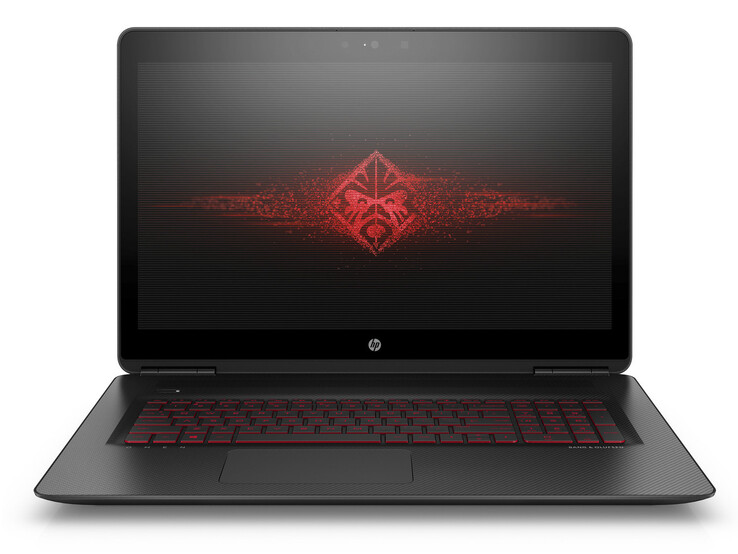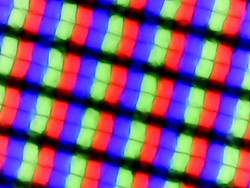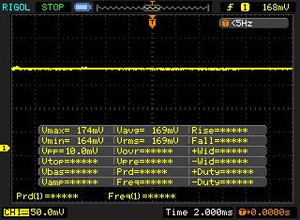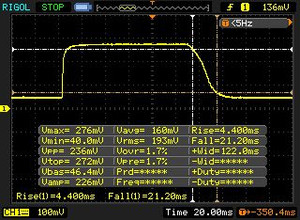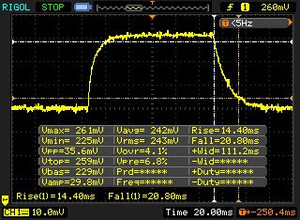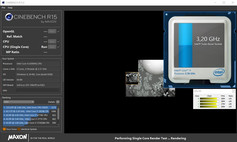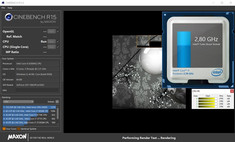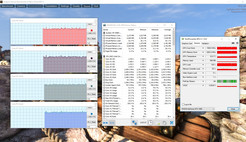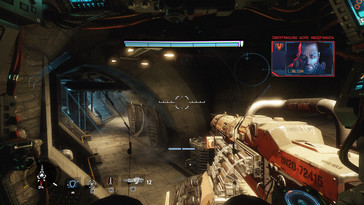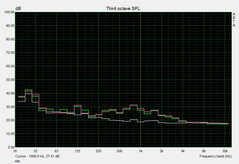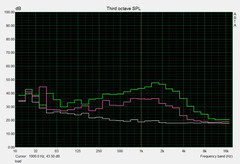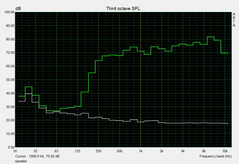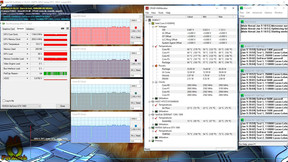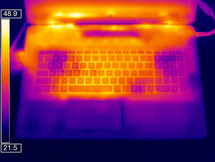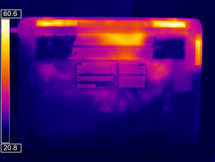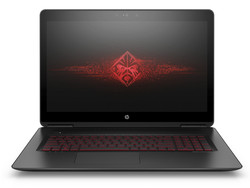HP Omen 17 (GTX 1060) Notebook Review

For the original German review, see here.
The Omen 17 w100ng is the present entry-level model in HP's 17.3-inch gaming-laptop range. A Core i5-6300HQ processor and GeForce GTX 1060 GPU are installed. Thus, the laptop's performance is weaker than that of the Omen 17-w110ng (Core i7-6700HQ, GeForce GTX 1070) that we have already tested. However, its price of almost 1300 Euros (~$1390) is also roughly 500 Euros (~$534) lower than that of its sister model. The Omen finds rivals in laptops such as Asus' GL702VM and MSI's GS73VR 6RF.
Since both Omen 17 models feature an identical build, we will not go in-depth about casing, connectivity, input devices, speakers or display. The corresponding information can be found in the review of the Omen 17-w110ng.
Connectivity
The following information is to answer questions that are often asked in our forum:
- The HDMI port (version 2.0) supports resolutions of up to 4096x2160 pixels (@60 Hz) - at least according to the Omen's maintenance manual
- The Omen offers G-Sync support also for external monitors - this information can be found in the maintenance manual
- The installed screen has a refresh rate of 75 Hz
| SD Card Reader | |
| average JPG Copy Test (av. of 3 runs) | |
| Gigabyte P57X v6 | |
| HP Omen 17-w110ng | |
| HP Omen 17-w100ng | |
| Asus GL702VM-GC102D | |
| MSI GS73VR 6RF | |
| maximum AS SSD Seq Read Test (1GB) | |
| Gigabyte P57X v6 | |
| HP Omen 17-w110ng | |
| HP Omen 17-w100ng | |
| Asus GL702VM-GC102D | |
| MSI GS73VR 6RF | |
| Networking | |
| iperf3 receive AX12 | |
| HP Omen 17-w110ng | |
| HP Omen 17-w100ng | |
| iperf3 transmit AX12 | |
| HP Omen 17-w110ng | |
| HP Omen 17-w100ng | |
Display
The Omen is furnished with the same Full HD panel as its sister model that we tested. Nevertheless, the rates differ slightly. This is normal as two identical screens will never correspond to 100%. It is a bright, high-contrast, viewing-angle stable IPS panel. Positive: PWM-flickering is never an issue.
The screen supports Nvidia's G-Sync technology. Thus, the frame rates of the panel and the GPU are geared to each other. This is to ensure as smooth as possible images without reproduction errors - especially in computer games.
| |||||||||||||||||||||||||
Brightness Distribution: 84 %
Center on Battery: 342 cd/m²
Contrast: 1069:1 (Black: 0.32 cd/m²)
ΔE ColorChecker Calman: 4.35 | ∀{0.5-29.43 Ø4.78}
ΔE Greyscale Calman: 3.73 | ∀{0.09-98 Ø5}
86% sRGB (Argyll 1.6.3 3D)
57% AdobeRGB 1998 (Argyll 1.6.3 3D)
63.3% AdobeRGB 1998 (Argyll 3D)
86.6% sRGB (Argyll 3D)
67.2% Display P3 (Argyll 3D)
Gamma: 2.23
CCT: 6801 K
| HP Omen 17-w100ng LG Philips LGD046E, 1920x1080 | Asus GL702VM-GC102D LG Philips LP173WF4-SPF3, 1920x1080 | MSI GS73VR 6RF 1920x1080 | Gigabyte P57X v6 LGD0469, 1920x1080 | HP Omen 17-w110ng LG Philips LGD046E, 1920x1080 | |
|---|---|---|---|---|---|
| Display | -3% | 27% | 1% | -2% | |
| Display P3 Coverage (%) | 67.2 | 65.1 -3% | 90 34% | 68 1% | 66.6 -1% |
| sRGB Coverage (%) | 86.6 | 83.5 -4% | 99.9 15% | 87.5 1% | 84.1 -3% |
| AdobeRGB 1998 Coverage (%) | 63.3 | 61.1 -3% | 83.6 32% | 64 1% | 61.5 -3% |
| Response Times | -1% | 41% | 1% | -1% | |
| Response Time Grey 50% / Grey 80% * (ms) | 35 ? | 38 ? -9% | 28 ? 20% | 33.6 ? 4% | 37 ? -6% |
| Response Time Black / White * (ms) | 25 ? | 23 ? 8% | 9.6 ? 62% | 25.6 ? -2% | 24 ? 4% |
| PWM Frequency (Hz) | |||||
| Screen | -28% | 15% | -10% | 2% | |
| Brightness middle (cd/m²) | 342 | 326 -5% | 337.2 -1% | 329.2 -4% | 362 6% |
| Brightness (cd/m²) | 331 | 312 -6% | 315 -5% | 321 -3% | 342 3% |
| Brightness Distribution (%) | 84 | 91 8% | 86 2% | 93 11% | 87 4% |
| Black Level * (cd/m²) | 0.32 | 0.5 -56% | 0.308 4% | 0.267 17% | 0.31 3% |
| Contrast (:1) | 1069 | 652 -39% | 1095 2% | 1233 15% | 1168 9% |
| Colorchecker dE 2000 * | 4.35 | 6.3 -45% | 2.96 32% | 5.93 -36% | 4.5 -3% |
| Colorchecker dE 2000 max. * | 9.24 | 11.69 -27% | 5.45 41% | 11.07 -20% | 9.31 -1% |
| Greyscale dE 2000 * | 3.73 | 7.37 -98% | 2.57 31% | 6.72 -80% | 3.48 7% |
| Gamma | 2.23 99% | 2.37 93% | 2.25 98% | 2.12 104% | 2.23 99% |
| CCT | 6801 96% | 7116 91% | 7114 91% | 7611 85% | 6144 106% |
| Color Space (Percent of AdobeRGB 1998) (%) | 57 | 55 -4% | 74.3 30% | 57 0% | 55 -4% |
| Color Space (Percent of sRGB) (%) | 86 | 83 -3% | 100 16% | 87 1% | 84 -2% |
| Total Average (Program / Settings) | -11% /
-19% | 28% /
21% | -3% /
-6% | -0% /
1% |
* ... smaller is better
Screen Flickering / PWM (Pulse-Width Modulation)
| Screen flickering / PWM not detected | |||
In comparison: 53 % of all tested devices do not use PWM to dim the display. If PWM was detected, an average of 8142 (minimum: 5 - maximum: 343500) Hz was measured. | |||
Display Response Times
| ↔ Response Time Black to White | ||
|---|---|---|
| 25 ms ... rise ↗ and fall ↘ combined | ↗ 4 ms rise | |
| ↘ 21 ms fall | ||
| The screen shows relatively slow response rates in our tests and may be too slow for gamers. In comparison, all tested devices range from 0.1 (minimum) to 240 (maximum) ms. » 58 % of all devices are better. This means that the measured response time is worse than the average of all tested devices (20.2 ms). | ||
| ↔ Response Time 50% Grey to 80% Grey | ||
| 35 ms ... rise ↗ and fall ↘ combined | ↗ 14 ms rise | |
| ↘ 21 ms fall | ||
| The screen shows slow response rates in our tests and will be unsatisfactory for gamers. In comparison, all tested devices range from 0.165 (minimum) to 636 (maximum) ms. » 47 % of all devices are better. This means that the measured response time is worse than the average of all tested devices (31.7 ms). | ||
Performance
Hewlett Packard launches gaming laptops in a 15.6 and 17.3-inch size under the label "Omen". The present device is the entry-level model of the 17.3-inch lineup. It renders all up-to-date computer games smoothly on the screen. Our review sample retails for around 1300 Euros (~$1390).
Processor
With HP's Omen 17 w100ng, we are facing a gaming laptop that does not sport the Core i7-6700HQ often used in such devices. Instead, HP installs the cheaper Core i5-6300HQ. The CPU clocks at a base speed of 2.3 GHz, which can be boosted to 2.8 GHz (four cores), 3 GHz (two cores) and 3.2 GHz (one core) via Turbo. The Core i5 not only differs in terms of its lower clock speeds from the named Core i7. Intel does not furnish the Core i5 with Hyper-Threading. Thus, every core of the 6300HQ can only process one thread. The 6700HQ can process two threads simultaneously. Consequently, the 6300HQ presents a much lower score than the 6700HQ in the multithread tests. The Core i5 processor performed our CPU tests at 2.8 to 3.2 GHz (single-thread) and 2.8 GHz (multithread).
| Cinebench R10 | |
| Rendering Multiple CPUs 32Bit | |
| HP Omen 17-w110ng | |
| Asus GL702VM-GC102D | |
| MSI GS73VR 6RF | |
| Acer Aspire V Nitro VN7-792G-55SF | |
| HP Omen 17-w100ng | |
| Dell XPS 15 2016 9550 | |
| Rendering Single 32Bit | |
| HP Omen 17-w110ng | |
| Asus GL702VM-GC102D | |
| Acer Aspire V Nitro VN7-792G-55SF | |
| MSI GS73VR 6RF | |
| HP Omen 17-w100ng | |
| Dell XPS 15 2016 9550 | |
| Geekbench 3 | |
| 32 Bit Single-Core Score | |
| Acer Aspire V Nitro VN7-792G-55SF | |
| HP Omen 17-w100ng | |
| Asus GL702VM-GC102D | |
| 32 Bit Multi-Core Score | |
| Asus GL702VM-GC102D | |
| Acer Aspire V Nitro VN7-792G-55SF | |
| HP Omen 17-w100ng | |
| Geekbench 4.0 | |
| 64 Bit Single-Core Score | |
| HP Omen 17-w100ng | |
| Asus GL702VM-GC102D | |
| 64 Bit Multi-Core Score | |
| Asus GL702VM-GC102D | |
| HP Omen 17-w100ng | |
| JetStream 1.1 - Total Score | |
| HP Omen 17-w110ng | |
| Gigabyte P57X v6 | |
| Asus GL702VM-GC102D | |
| MSI GS73VR 6RF | |
| HP Omen 17-w100ng | |
| Acer Aspire V Nitro VN7-792G-55SF | |
System Performance
The system's overall performance is beyond reproach. A fast SSD and strong processor ensure a fast-running system. The subjective impression is also reflected in the very good PCMark benchmark scores. A look at our comparison chart reveals that the stronger hardware in the Omen sister model does not bring advantages in everyday use. For example, the installed PCIe/NVMe SSD presents its virtues when launching the operating system (shorter booting times) and in computer games. The latter then has to be installed on the SSD.
| PCMark 7 Score | 5990 points | |
| PCMark 8 Home Score Accelerated v2 | 4711 points | |
| PCMark 8 Creative Score Accelerated v2 | 6858 points | |
| PCMark 8 Work Score Accelerated v2 | 5252 points | |
Help | ||
| PCMark 8 | |
| Home Score Accelerated v2 | |
| HP Omen 17-w110ng | |
| HP Omen 17-w100ng | |
| Asus GL702VM-GC102D | |
| Gigabyte P57X v6 | |
| MSI GS73VR 6RF | |
| Work Score Accelerated v2 | |
| HP Omen 17-w110ng | |
| HP Omen 17-w100ng | |
| Gigabyte P57X v6 | |
| Asus GL702VM-GC102D | |
| MSI GS73VR 6RF | |
Storage Devices
The system drive is a solid state drive by SanDisk. This M.2 model (2280) has a total capacity of 128 GB. Approximately 89 GB can be used ex-factory. The SSD's read rates are decent in total. The relatively low write rates reveal that it is not one of the top models among SSDs. Users wanting higher speeds can swap the installed SATA III SSD for a much faster (and more expensive) PCIe/NVMe model. A traditional 2.5-inch hard drive provides the needed storage capacity required in a gaming laptop. HP has opted for a 1-TB model (7200 RPM) by HGST. Both storage devices can be replaced, which would involve opening the laptop's casing.
| HP Omen 17-w100ng SanDisk Z400s SD8SNAT-128G | Asus GL702VM-GC102D HGST Travelstar 7K1000 HTS721010A9E630 | MSI GS73VR 6RF SanDisk SD8SN8U1T001122 | Gigabyte P57X v6 Transcend MTS800 256GB M.2 (TS256GMTS800) | HP Omen 17-w110ng Samsung PM951 NVMe MZVLV256 | |
|---|---|---|---|---|---|
| CrystalDiskMark 3.0 | -80% | 13% | 43% | 122% | |
| Read Seq (MB/s) | 495 | 134.6 -73% | 334.3 -32% | 481.7 -3% | 1156 134% |
| Write Seq (MB/s) | 180.2 | 130.6 -28% | 319 77% | 315.4 75% | 294.9 64% |
| Read 512 (MB/s) | 315.5 | 44.85 -86% | 242.3 -23% | 303.1 -4% | 616 95% |
| Write 512 (MB/s) | 172.4 | 63.3 -63% | 254.4 48% | 314.4 82% | 294.7 71% |
| Read 4k (MB/s) | 20.25 | 0.602 -97% | 20.3 0% | 25.93 28% | 42.7 111% |
| Write 4k (MB/s) | 76.1 | 1.146 -98% | 42.51 -44% | 84.6 11% | 153.3 101% |
| Read 4k QD32 (MB/s) | 141.6 | 1.106 -99% | 251.6 78% | 273.9 93% | 600 324% |
| Write 4k QD32 (MB/s) | 170.8 | 1.186 -99% | 167.1 -2% | 274.9 61% | 295.3 73% |
Graphics Card
The GeForce GTX 1060 graphics unit is installed into our present review sample. It is based on the Pascal architecture and is Nvidia's current entry-level model in the GPU premium class. The chip is always active. The integrated HD Graphics 530 is disabled ex-factory and the user cannot reactivate it. The GTX 1060 supports DirectX12. 6144 MB of GDDR5 video memory supports it. We measured a maximum clock speed of 1900 MHz. This rate can only be maintained for a short time. The GPU's average clock speed was approximately 1550 MHz during our test.
| 3DMark 06 Standard Score | 24318 points | |
| 3DMark 11 Performance | 10805 points | |
| 3DMark Ice Storm Standard Score | 111645 points | |
| 3DMark Cloud Gate Standard Score | 15394 points | |
| 3DMark Fire Strike Score | 8654 points | |
| 3DMark Fire Strike Extreme Score | 4806 points | |
| 3DMark Time Spy Score | 3339 points | |
Help | ||
| 3DMark | |
| 1280x720 Cloud Gate Standard Graphics | |
| HP Omen 17-w110ng | |
| Gigabyte P57X v6 | |
| Asus GL702VM-GC102D | |
| HP Omen 17-w100ng | |
| MSI GS73VR 6RF | |
| 1920x1080 Fire Strike Graphics | |
| HP Omen 17-w110ng | |
| MSI GS73VR 6RF | |
| HP Omen 17-w100ng | |
| Asus GL702VM-GC102D | |
| 3DMark 11 - 1280x720 Performance GPU | |
| Gigabyte P57X v6 | |
| HP Omen 17-w110ng | |
| MSI GS73VR 6RF | |
| HP Omen 17-w100ng | |
| Asus GL702VM-GC102D | |
Gaming Performance
The Omen renders almost every up-to-date game smoothly using the Full HD resolution and high-quality settings. The maximum quality level can be selected in many cases, as well. A look in our database shows that the resolution/quality level only has to be reduced in X-Plane from the games that we have tested. Taking an Omen model with a GeForce GTX 1070 graphics unit would be required for higher resolutions.
| BioShock Infinite - 1920x1080 Ultra Preset, DX11 (DDOF) | |
| Gigabyte P57X v6 | |
| HP Omen 17-w110ng | |
| MSI GS73VR 6RF | |
| HP Omen 17-w100ng | |
| Asus GL702VM-GC102D | |
| Schenker XMG P507 | |
| Razer Blade (2016) FHD | |
| Battlefield 4 - 1920x1080 Ultra Preset AA:4x MS | |
| HP Omen 17-w100ng | |
| Asus GL702VM-GC102D | |
| Razer Blade (2016) FHD | |
| Schenker XMG P507 | |
| Battlefield 1 - 1920x1080 Ultra Preset AA:T | |
| HP Omen 17-w110ng | |
| Asus GL702VM-GC102D | |
| HP Omen 17-w100ng | |
| Anno 2205 - 1920x1080 High Preset AA:4x | |
| Schenker XMG P507 | |
| Razer Blade (2016) FHD | |
| HP Omen 17-w100ng | |
| low | med. | high | ultra | |
|---|---|---|---|---|
| Tomb Raider (2013) | 290.5 | 289.2 | 274.9 | 140 |
| BioShock Infinite (2013) | 197.8 | 176.2 | 164.8 | 99.1 |
| Battlefield 4 (2013) | 188.8 | 172.8 | 155.7 | 101.5 |
| Anno 2205 (2015) | 81.9 | 75 | 64.7 | 30.2 |
| Just Cause 3 (2015) | 94.6 | 83 | 76.7 | 70.4 |
| Far Cry Primal (2016) | 94 | 82 | 73 | 59 |
| Deus Ex Mankind Divided (2016) | 97.1 | 93 | 56.5 | 29.2 |
| FIFA 17 (2016) | 276.7 | 270.8 | 222.5 | 227.3 |
| Battlefield 1 (2016) | 136.4 | 117.5 | 86.6 | 78.5 |
| Civilization 6 (2016) | 58.1 | 47.1 | 43 | 42.8 |
| Titanfall 2 (2016) | 143.5 | 143.5 | 89.7 | 80 |
Emissions
System Noise
The fans spin permanently in an audible range in idle mode. Once again, the BIOS option "Fan always on" is responsible for this in this HP laptop. The fans are sometimes inactive after unchecking this option. The fan does not speed up sporadically in idle. The noise level increases during load. We measured a noise level of a high 54 dB during the stress test. By comparison: The much slimmer Asus GL702VM produces less noise. The level ranges around 44 dB (40-47 dB) in gaming sessions.
Noise level
| Idle |
| 35 / 36 / 37 dB(A) |
| Load |
| 44 / 54 dB(A) |
 | ||
30 dB silent 40 dB(A) audible 50 dB(A) loud |
||
min: | ||
| HP Omen 17-w100ng 6300HQ, GeForce GTX 1060 Mobile | Asus GL702VM-GC102D 6700HQ, GeForce GTX 1060 Mobile | MSI GS73VR 6RF 6700HQ, GeForce GTX 1060 Mobile | Gigabyte P57X v6 6700HQ, GeForce GTX 1070 Mobile | HP Omen 17-w110ng 6700HQ, GeForce GTX 1070 Mobile | |
|---|---|---|---|---|---|
| Noise | 10% | 6% | 4% | 4% | |
| off / environment * (dB) | 31 | 30.5 2% | 28.4 8% | 29.7 4% | 30 3% |
| Idle Minimum * (dB) | 35 | 31.4 10% | 31.9 9% | 33.2 5% | 33 6% |
| Idle Average * (dB) | 36 | 31.4 13% | 32 11% | 33.2 8% | 34 6% |
| Idle Maximum * (dB) | 37 | 31.5 15% | 34 8% | 33.2 10% | 35 5% |
| Load Average * (dB) | 44 | 40.9 7% | 47 -7% | 47.5 -8% | 45 -2% |
| Load Maximum * (dB) | 54 | 46.2 14% | 49.4 9% | 52.5 3% | 52 4% |
* ... smaller is better
Temperature
The Omen performed our stress test (Prime95 and Furmark run for at least one hour) differently in AC and battery modes. The processor clocked at 2.8 GHz in AC mode. It occasionally throttled to 800 MHz. The graphics unit clocked at speeds around 1200 MHz. The speeds in battery mode were 1.8 to 1.9 GHz (CPU) and 1.6 GHz (GPU). The laptop did not get excessively hot. 40 °C was only surpassed on four measuring points during the stress test. Not very surprising: The Omen's sister model heats up much more due to its higher-performance hardware.
(±) The maximum temperature on the upper side is 41.5 °C / 107 F, compared to the average of 40.4 °C / 105 F, ranging from 21.2 to 68.8 °C for the class Gaming.
(-) The bottom heats up to a maximum of 45.5 °C / 114 F, compared to the average of 43.3 °C / 110 F
(+) In idle usage, the average temperature for the upper side is 28.7 °C / 84 F, compared to the device average of 33.9 °C / 93 F.
(+) The palmrests and touchpad are reaching skin temperature as a maximum (33.5 °C / 92.3 F) and are therefore not hot.
(-) The average temperature of the palmrest area of similar devices was 28.9 °C / 84 F (-4.6 °C / -8.3 F).
| HP Omen 17-w100ng 6300HQ, GeForce GTX 1060 Mobile | Asus GL702VM-GC102D 6700HQ, GeForce GTX 1060 Mobile | MSI GS73VR 6RF 6700HQ, GeForce GTX 1060 Mobile | Gigabyte P57X v6 6700HQ, GeForce GTX 1070 Mobile | HP Omen 17-w110ng 6700HQ, GeForce GTX 1070 Mobile | |
|---|---|---|---|---|---|
| Heat | -11% | -9% | -24% | -4% | |
| Maximum Upper Side * (°C) | 41.5 | 53.1 -28% | 50.8 -22% | 59 -42% | 45 -8% |
| Maximum Bottom * (°C) | 45.5 | 44.9 1% | 60 -32% | 66 -45% | 54.3 -19% |
| Idle Upper Side * (°C) | 31.8 | 32.9 -3% | 27.4 14% | 33.2 -4% | 29.6 7% |
| Idle Bottom * (°C) | 29.6 | 33.4 -13% | 28.8 3% | 30.6 -3% | 28.6 3% |
* ... smaller is better
Speakers
HP Omen 17-w100ng audio analysis
(+) | speakers can play relatively loud (87 dB)
Bass 100 - 315 Hz
(-) | nearly no bass - on average 23.9% lower than median
(±) | linearity of bass is average (12.3% delta to prev. frequency)
Mids 400 - 2000 Hz
(+) | balanced mids - only 2.2% away from median
(+) | mids are linear (4.6% delta to prev. frequency)
Highs 2 - 16 kHz
(+) | balanced highs - only 4.6% away from median
(+) | highs are linear (4.5% delta to prev. frequency)
Overall 100 - 16.000 Hz
(±) | linearity of overall sound is average (16.6% difference to median)
Compared to same class
» 43% of all tested devices in this class were better, 7% similar, 50% worse
» The best had a delta of 6%, average was 18%, worst was 132%
Compared to all devices tested
» 28% of all tested devices were better, 6% similar, 67% worse
» The best had a delta of 4%, average was 24%, worst was 134%
Asus GL702VM-GC102D audio analysis
(-) | not very loud speakers (64 dB)
Bass 100 - 315 Hz
(±) | reduced bass - on average 7.7% lower than median
(±) | linearity of bass is average (14% delta to prev. frequency)
Mids 400 - 2000 Hz
(+) | balanced mids - only 1.5% away from median
(+) | mids are linear (6.3% delta to prev. frequency)
Highs 2 - 16 kHz
(±) | reduced highs - on average 5.3% lower than median
(±) | linearity of highs is average (9.8% delta to prev. frequency)
Overall 100 - 16.000 Hz
(±) | linearity of overall sound is average (16.7% difference to median)
Compared to same class
» 43% of all tested devices in this class were better, 10% similar, 47% worse
» The best had a delta of 6%, average was 18%, worst was 132%
Compared to all devices tested
» 28% of all tested devices were better, 7% similar, 65% worse
» The best had a delta of 4%, average was 24%, worst was 134%
Frequency diagram in comparison (checkboxes above can be turned on/off!)
Energy Management
Power Consumption
The Omen proved to be very thirsty in idle mode. We measured a maximum power consumption of 29 watts. Asus' GL702VM shows that lower power consumption is possible even when the iGPU is disabled. The energy requirement climbed up to 141 watts during the stress test. The power supply is far from being exhausted. HP includes the 230-watt power supply that we know from the GTX 1070 sister model. A more compact model would have sufficed here.
| Off / Standby | |
| Idle | |
| Load |
|
Key:
min: | |
| HP Omen 17-w100ng 6300HQ, GeForce GTX 1060 Mobile | Asus GL702VM-GC102D 6700HQ, GeForce GTX 1060 Mobile | MSI GS73VR 6RF 6700HQ, GeForce GTX 1060 Mobile | Gigabyte P57X v6 6700HQ, GeForce GTX 1070 Mobile | HP Omen 17-w110ng 6700HQ, GeForce GTX 1070 Mobile | |
|---|---|---|---|---|---|
| Power Consumption | 3% | -35% | -40% | -19% | |
| Idle Minimum * (Watt) | 17 | 15.6 8% | 22.6 -33% | 18.4 -8% | 19 -12% |
| Idle Average * (Watt) | 22 | 20.2 8% | 32.7 -49% | 22.8 -4% | 25 -14% |
| Idle Maximum * (Watt) | 29 | 21.4 26% | 32.8 -13% | 24 17% | 31 -7% |
| Load Average * (Watt) | 72 | 90 -25% | 114.7 -59% | 175.5 -144% | 90 -25% |
| Load Maximum * (Watt) | 141 | 147 -4% | 167.9 -19% | 229.5 -63% | 193 -37% |
* ... smaller is better
Battery Runtime
The Omen achieved a runtime of 6:04 hours in our practical Wi-Fi test - some office laptops cannot compete with that. We simulate the load needed for opening websites here. The "Balanced" profile is enabled, the energy-saving functions are disabled, and the screen's brightness is dimmed to approximately 150 cd/m². The laptop managed a runtime of 5:13 hours on one charged battery in our video test. Here, the short movie Big Buck Bunny (H.264 encoding, 1920x1080 pixels) is looped. The wireless modules and energy-saving functions are disabled, and the screen's brightness is set to approximately 150 cd/m². In total, the Omen delivers a very good battery life for a gaming laptop. The higher-performance sister model is clearly outperformed.
| HP Omen 17-w100ng 6300HQ, GeForce GTX 1060 Mobile, 95.8 Wh | Asus GL702VM-GC102D 6700HQ, GeForce GTX 1060 Mobile, 76 Wh | MSI GS73VR 6RF 6700HQ, GeForce GTX 1060 Mobile, 65 Wh | Gigabyte P57X v6 6700HQ, GeForce GTX 1070 Mobile, 75.81 Wh | HP Omen 17-w110ng 6700HQ, GeForce GTX 1070 Mobile, 95 Wh | |
|---|---|---|---|---|---|
| Battery runtime | -30% | -43% | -32% | -25% | |
| Reader / Idle (h) | 9.1 | 5.9 -35% | 5.9 -35% | 7 -23% | 7.2 -21% |
| H.264 (h) | 5.2 | 4.4 -15% | 3.9 -25% | ||
| WiFi v1.3 (h) | 6.1 | 4.2 -31% | 3.6 -41% | 3.4 -44% | 4.1 -33% |
| Load (h) | 2.4 | 1.5 -37% | 1.1 -54% | 1.7 -29% | 1.9 -21% |
Pros
Cons
Verdict
The entry-level model of the Omen lineup does not feature a Core i7 CPU but "only" offers a Core i5-6300HQ processor. Consequently, the buyer "only" has to cough up 1300 Euros (~$1390). However, the installed processor has more than enough computing power for all common application scenarios. The 6300HQ and GeForce GTX 1060 graphics unit combination renders almost every up-to-date game in Full HD resolution using high, and sometimes even maximum, quality settings. Nvidia's G-Sync technology ensures a smooth image reproduction on the 75-Hz screen.
The smooth-running system is owed to the SATA III SSD. However, there is still some room for more. The SSD could be swapped for a much faster PCIe/NVMe model. Replacing the installed 1 TB hard drive would also be possible. The matte IPS panel pleases with high brightness, high contrast, and stable viewing angles.
With the Omen 17 w100ng, HP launches a well-balanced entry-level model into the world of gaming laptops.
The Omen is not free of reproach: HP should, for example, rework the noise development. The laptop produces more noise than is necessary. The cooling system seems to be designed for the combination of Core i7-6700 and GeForce GTX 1070. A BIOS update could improve things here. The laptop cannot offer Thunderbolt 3 or USB 3.1 Gen2 ports, either. We expect such a port in a 2016/2017 laptop from this price range.
HP Omen 17-w100ng
- 01/18/2017 v6 (old)
Sascha Mölck




